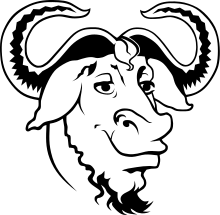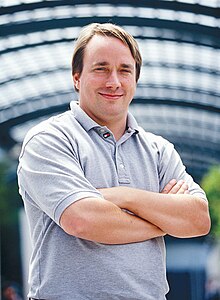| Revision as of 12:34, 20 December 2006 editPeashy (talk | contribs)164 editsm Copy edits← Previous edit | Revision as of 12:46, 20 December 2006 edit undoPeashy (talk | contribs)164 editsm →Previous developments: linksNext edit → | ||
| Line 8: | Line 8: | ||
| ] | ] | ||
| In 1983 ] started the ] with the goal of creating a free ]-like, ]-compatible operating system. Two years later he created the ] (FSF) and developed the ] (GPL), in order to spread software freely. In this way the GNU software developed very fast and by many people was developed further. Within a short time a multiplicity of programs developed, so that by the beginning of the 1990s there was almost enough already available GNU software in order to create its own operating system. However a Kernel was still missing. This was to be developed in the ] project. But Hurd proved to develop very sluggishly, because finding and repairing errors (debugging) was very difficult and laborious due to technical characteristics of the microkernel design. Another project concerned with a free operating system in the 1980s was the ], BSD for short. This was developed at Berkeley |
In 1983 ] started the ] with the goal of creating a free ]-like, ]-compatible ]. Two years later he created the ] (FSF) and developed the ] (GPL), in order to spread software freely. In this way the GNU software developed very fast and by many people was developed further. Within a short time a multiplicity of programs developed, so that by the beginning of the 1990s there was almost enough already available GNU software in order to create its own operating system. However a Kernel was still missing. This was to be developed in the ] project. But Hurd proved to develop very sluggishly, because finding and repairing errors (debugging) was very difficult and laborious due to technical characteristics of the microkernel design. Another project concerned with a free operating system in the 1980s was the ], BSD for short. This was developed at ] from the 6th edition of Unix from ]. However since AT&T Unix code was still contained in BSD, at the beginning of the 1990s AT&T filed a lawsuit against the University of Berkeley, which strongly limited the development of BSD and greatly slowed development. Thus the early 1990s gave it no complete, free system. The future of BSD was uncertain because of the litigation, development stalled, and although the GNU project was gradually developing, it lacked a well-behaved UNIX Kernel. In fact, it was more of a loose collection of free software projects, which could be translated on the most diverse (commercial) UNIX variants by means of the GNU ] and were executable. | ||
| === Emergence of Linux === | === Emergence of Linux === | ||
Revision as of 12:46, 20 December 2006
| This article may require copy editing for grammar, style, cohesion, tone, or spelling. You can assist by editing it. (Learn how and when to remove this message) |

The history of the Linux kernel is marked by constant growth. Having gone from a small number of C Programming Language source code files to currently about 40MB of source code since its 1991 introduction, it has along the way been put under a free license, and seen various controversies about the use of its name.
Historical developments
Previous developments

In 1983 Richard Stallman started the GNU Project with the goal of creating a free UNIX-like, POSIX-compatible operating system. Two years later he created the Free software Foundation (FSF) and developed the GNU General Public License (GPL), in order to spread software freely. In this way the GNU software developed very fast and by many people was developed further. Within a short time a multiplicity of programs developed, so that by the beginning of the 1990s there was almost enough already available GNU software in order to create its own operating system. However a Kernel was still missing. This was to be developed in the GNU Hurd project. But Hurd proved to develop very sluggishly, because finding and repairing errors (debugging) was very difficult and laborious due to technical characteristics of the microkernel design. Another project concerned with a free operating system in the 1980s was the Berkeley Software Distribution, BSD for short. This was developed at Berkeley university from the 6th edition of Unix from AT&T. However since AT&T Unix code was still contained in BSD, at the beginning of the 1990s AT&T filed a lawsuit against the University of Berkeley, which strongly limited the development of BSD and greatly slowed development. Thus the early 1990s gave it no complete, free system. The future of BSD was uncertain because of the litigation, development stalled, and although the GNU project was gradually developing, it lacked a well-behaved UNIX Kernel. In fact, it was more of a loose collection of free software projects, which could be translated on the most diverse (commercial) UNIX variants by means of the GNU compiler and were executable.
Emergence of Linux

In 1991 in Helsinki Linus Torvalds began the development of Linux. It was initially a terminal emulation, which Torvalds used for access to the large UNIX servers of the university. He wrote the program specifically for the hardware and independent of an operating system, because he wanted to use the functions of his new PC with a 80386 processor, which is still among the standard today, optimally. The operating system used during development was Minix, and the initial compiler was the GNU C compiler, which is still the main choice for compiling Linux today (although Linux will compile under other compilers, such as the Intel C Compiler).
As Torvalds writes in his book, Just for Fun (with David Diamond, 2001), he eventually realised that he had written an operating system. On 25 August 1991 he announced this system in a Usenet Posting to the group comp.os.minix. This Usenet Posting is quoted again and again in many places and might rank among the most well-known Postings in the Usenet:
- "Hello everybody out there using minix -
- I'm doing a (free) operating system (just a hobby, won't be big and professional like gnu) for 386(486) AT clones. This has been brewing since april, and is starting to get ready. I'd like any feedback on things people like/dislike in minix, as my OS resembles it somewhat (same physical layout of the file-system (due to practical reasons) among other things).
- I've currently ported bash(1.08) and gcc(1.40), and things seem to work. This implies that I'll get something practical within a few months, and I'd like to know what features most people would want. Any suggestions are welcome, but I won't promise I'll implement them :-)
- Linus (torvalds@kruuna.helsinki.fi)
- PS. Yes – it's free of any minix code, and it has a multi-threaded fs. It is NOT portable (uses 386 task switching etc), and it probably never will support anything other than AT-harddisks, as that's all I have :-(."
The name Linux
Linux was to be called Freax after the will of Linus Torvalds , a word creation out Freak (crazy person or, someone, who is enthusiastic for something), Free for free software and the usual x in allusion to the similarity to Unix. For this reason during the start of his work on the system he had put the files under Freax for about a half year. Torvalds did consider the name Linux already but, it appeared too egotistical to him. In order to give other people the ability to cooperate in the system or to suggest improvements, the files were put up in September 1991 on the ftp server (ftp.funet.fi) of the Helsinki University OF Technology (HAT). The person responsible at that time for the server, Ari Lemmke (coworker at the HAT), did not agree with the name Freax, he preferred the work name Linux. Without discussing with Torvalds, he simply called the selection at the server Linux, which was finally accepted by Torvalds, over long discussions to avoid and also, how Torvalds admits, because Linux was simply the better name. In the source code of version 0.01 of Linux the name Freax still came forwards („Makefile for the FREAX kernel “), only later was the name Linux used. Thus the name actually not planned at all became generally accepted world-wide.
Linux under the GPL
Torvalds first published Linux under its own license. He later decided however to use the GNU copyleft. The first version under the GNU copyleft was version 0.12 in January 1992, the change of license was noted in the CHANGE log . In the middle of December 1992 he published version 0.99 containing for the first time the text of the GPL .
This was the step that made it possible to develop Linux quickly and efficiently with the help of several other developers from around the world. Thus a growing community of developers created a kernel that was state of the art and competitive with proprietary systems.
Later Linus Torvalds said in an interview that the decision to place Linux under the GPL was his best ever: “Making Linux GPL'd was definitely the best thing I ever did.”.
References
- Torvalds, Linux. What would you like to see most in minix? Usenet group comp.os.minix, August 25, 1991.
- Linux-Kernel, Version 0.99 (Z-kompimiert, 830 kB) auf dem kernel.org-FTP-Server. Dezember 1992
- Hiroo Yamagata: The Pragmatist of Free Software Linus Torvalds Interview, 05.08.1997